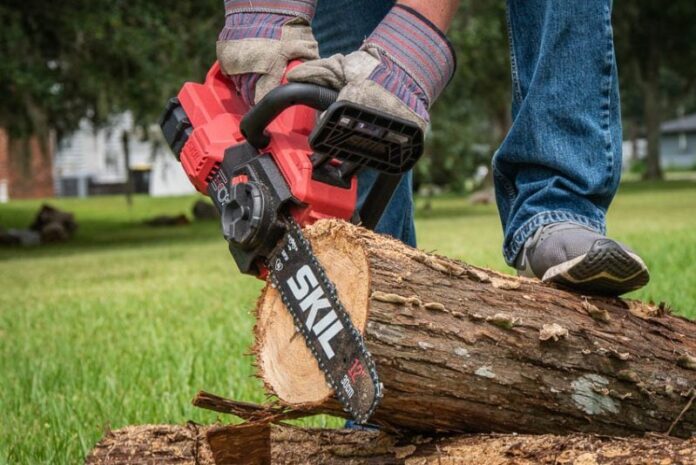Battery-powered tools have revolutionized home maintenance, and chainsaws are no exception to this trend. A battery chainsaw offers compelling advantages for homeowners tackling typical yard work and small-scale projects. Industry data from power tool manufacturers shows that battery chainsaw sales have increased by 185% over the past five years, as lithium-ion technology improvements have made these tools viable alternatives to traditional gas-powered models for many applications.
Reduced Noise and Neighbor Relations
One of the most immediately noticeable advantages of battery chainsaws is their significantly lower noise output. While gas chainsaws typically produce 100-110 decibels of noise, battery models usually operate at 85-95 decibels. This difference might not sound dramatic, but decibel scales are logarithmic—a 10-decibel reduction represents roughly half the perceived noise level.
This noise reduction matters tremendously for suburban homeowners who need to maintain good relationships with neighbors. You can operate a battery chainsaw early in the morning or later in the evening without creating the disruptive noise associated with gas models. Many municipal noise ordinances that restrict gas-powered tools during certain hours don’t apply to quieter battery alternatives.
The reduced noise also benefits the operator. Extended exposure to chainsaw noise can cause hearing damage over time, even with ear protection. Battery models reduce this risk significantly, making them safer for regular home use where you might not always remember to wear proper hearing protection.
Environmental Impact and Emissions
Battery chainsaws produce zero direct emissions during operation, which matters more than you might initially think. Gas chainsaws are actually significant polluters—the California Air Resources Board found that operating a gas chainsaw for one hour produces emissions equivalent to driving a modern car approximately 100 miles.
For homeowners conscious about their environmental footprint, this difference is substantial. If you use a chainsaw for 10-15 hours annually for typical yard maintenance, switching to battery power eliminates emissions equivalent to 1,000-1,500 miles of car driving.
The environmental benefits extend beyond emissions. Battery chainsaws don’t require oil and gas mixing, eliminating the risk of fuel spills during storage or refueling. They also don’t produce the hydrocarbon emissions that contribute to ground-level ozone formation in urban areas.
Maintenance Requirements and Long-Term Costs
Gas chainsaws require significantly more maintenance than battery models. Two-stroke engines need fuel mixing, air filter cleaning, spark plug replacement, and carburetor adjustments. These maintenance tasks require time, knowledge, and ongoing costs for replacement parts and specialized oils.
Battery chainsaws eliminate most engine-related maintenance. The main requirements are keeping the chain sharp, ensuring proper chain tension, and occasionally cleaning the unit. Bar and chain maintenance is identical between gas and battery models, but everything else is simplified.
Fuel costs add up over time. Gas chainsaws require specialized two-stroke oil mixed with gasoline, and both components have become increasingly expensive. Battery chainsaws only require electricity for charging, which typically costs less than $1 per month for typical homeowner usage patterns.
Storage and Seasonal Considerations
Gas chainsaws create storage challenges that battery models avoid entirely. Gasoline can go stale and damage engine components if not properly treated for storage, requiring fuel stabilizers or complete fuel system drainage before long-term storage.
Two-stroke engines can develop starting problems after sitting unused for months, often requiring professional servicing to get running again. These issues are particularly common when chainsaws sit unused through winter months then refuse to start when needed for spring cleanup.
Battery chainsaws store easily without any special preparation. Remove the battery, store both components in a dry location, and they’re ready to use whenever needed. No fuel mixing, no starting procedures, no maintenance concerns during storage periods.
Instant Start and Operational Convenience
Gas chainsaws can be frustrating to start, especially after sitting unused or in cold weather. The typical starting process involves checking fuel levels, engaging chokes, pulling starting cords repeatedly, and adjusting throttles—a process that can take several minutes and considerable physical effort.
Battery chainsaws start instantly with the press of a button. This convenience becomes significant when you’re working on projects that require frequent stopping and starting, such as pruning multiple branches or cutting firewood to specific lengths.
The instant-start capability also improves safety. There’s no need to balance a running saw while preparing to make cuts, and you can shut off power immediately when moving between cutting locations or repositioning yourself.
Power-to-Weight Ratios and User Fatigue
Modern battery chainsaws achieve impressive power-to-weight ratios that make them comfortable for extended use. High-quality lithium-ion batteries provide substantial power while weighing less than the fuel tank of equivalent gas models when filled.
Weight distribution is generally better in battery models because batteries mount low on the saw body, creating better balance than gas models where the engine sits high above the cutting bar. This improved balance reduces operator fatigue during extended use.
The reduced vibration of battery models also contributes to user comfort. Gas engines create significant vibration that can cause hand and arm fatigue during extended operation. Battery motors run much more smoothly, reducing operator stress during longer projects.
Cost Analysis for Typical Home Use
Initial purchase prices for quality battery chainsaws have decreased significantly as the technology has matured. While professional-grade battery models still cost more than entry-level gas saws, the price gap has narrowed considerably.
When calculating total ownership costs, battery models often prove more economical for typical homeowner use patterns. Elimination of fuel costs, reduced maintenance expenses, and avoided repair costs can offset higher initial purchase prices within 2-3 years of regular use.
